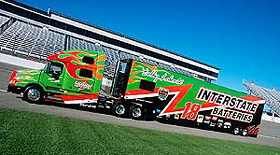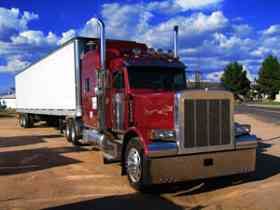Weight Distribution In Winter
Topic 12626 | Page 2
Ok, to be honest you guys are all over the place on this one. Not only are you contradicting yourselves at times, but you're only talking about how doing something helps in a certain set of circumstances but you're not talking about the disadvantages you're also creating at the same time. Everything you do is a compromise. When you make an adjustment it will help in certain circumstances but cause problems in others.
The bottom line is that you want the weight on your tandem sets (drive axles and trailer tandems) to be distributed as evenly as possible. Why? Because you want each set to have equal amounts of traction under braking and turning forces. If you put more weight on one set than the other you're creating a condition that makes it easier to lose traction on the lighter set of tandems.
For instance, say you put more weight on your drive axles. Now when you hit the brakes you have a better chance of locking up your trailer tandems and going into a trailer jackknife. If you put more weight on your trailer tandems you're creating the opposite circumstance. You're increasing the likelihood of losing traction on the lighter drive axles which increases your chances of going into a tractor jackknife.
As far as the "whipping effect" or "tail wagging" caused by having too much weight on the trailer tandems - you would need a lot more weight on the trailer tandems to be able to distinguish the difference. Even a few thousand pounds isn't going to make any noticeable difference on a rig that's approaching 80,000 pounds and 70 feet long. If you were maybe 10,000 pounds or more heavier on the trailer tandems than the drive axles you might feel a difference but it would be nearly unfathomable for someone to load a trailer that far off. You would almost have to do it on purpose.
Another myth I'd like to debunk even though it hasn't been said here (yet) is the ole "I can feel it when I'm a little overweight on one of my axles" myth - that's complete hogwash. Don't kid yourself. These trucks weigh 80,000 pounds, they're almost 70 feet long, and you're sitting on top of three separate levels of air ride suspension. You have air suspension between the axles and frame, air suspension between the frame and cab, and an air suspension seat. So for instance, to claim you can tell when you're 500 pounds over on your trailer tandems would mean you can somehow feel that you're overweight by less than 1% of your total weight on a set of axles that are about 50 feet behind the cab and separated from you by three levels of air suspension. I'm sorry, but you're kidding yourself and I'll slap money on the table any day of the week if you want to try to prove this to me.
As far as the steer axles go you won't really have much of a choice. The 5th wheel has a "sweet spot" for any particular tractor where the weight is distributed just right. You set it there and forget it. So you won't be manually adjusting your weight on the steer tires, nor should you try to once you have it in the right place.
So overall the safest, surest thing to do is get your weight distributed as evenly as possible between your tractor and trailer tandems. That will give you the best margin of safety under all circumstances - accelerating, braking, and turning.
Tandems:
Tandem Axles
A set of axles spaced close together, legally defined as more than 40 and less than 96 inches apart by the USDOT. Drivers tend to refer to the tandem axles on their trailer as just "tandems". You might hear a driver say, "I'm 400 pounds overweight on my tandems", referring to his trailer tandems, not his tractor tandems. Tractor tandems are generally just referred to as "drives" which is short for "drive axles".
Tandem:
Tandem Axles
A set of axles spaced close together, legally defined as more than 40 and less than 96 inches apart by the USDOT. Drivers tend to refer to the tandem axles on their trailer as just "tandems". You might hear a driver say, "I'm 400 pounds overweight on my tandems", referring to his trailer tandems, not his tractor tandems. Tractor tandems are generally just referred to as "drives" which is short for "drive axles".
Once again you are the voice of reason. Thank you Brett.

Ok, to be honest you guys are all over the place on this one. Not only are you contradicting yourselves at times, but you're only talking about how doing something helps in a certain set of circumstances but you're not talking about the disadvantages you're also creating at the same time. Everything you do is a compromise. When you make an adjustment it will help in certain circumstances but cause problems in others.
The bottom line is that you want the weight on your tandem sets (drive axles and trailer tandems) to be distributed as evenly as possible. Why? Because you want each set to have equal amounts of traction under braking and turning forces. If you put more weight on one set than the other you're creating a condition that makes it easier to lose traction on the lighter set of tandems.
For instance, say you put more weight on your drive axles. Now when you hit the brakes you have a better chance of locking up your trailer tandems and going into a trailer jackknife. If you put more weight on your trailer tandems you're creating the opposite circumstance. You're increasing the likelihood of losing traction on the lighter drive axles which increases your chances of going into a tractor jackknife.
As far as the "whipping effect" or "tail wagging" caused by having too much weight on the trailer tandems - you would need a lot more weight on the trailer tandems to be able to distinguish the difference. Even a few thousand pounds isn't going to make any noticeable difference on a rig that's approaching 80,000 pounds and 70 feet long. If you were maybe 10,000 pounds or more heavier on the trailer tandems than the drive axles you might feel a difference but it would be nearly unfathomable for someone to load a trailer that far off. You would almost have to do it on purpose.
Another myth I'd like to debunk even though it hasn't been said here (yet) is the ole "I can feel it when I'm a little overweight on one of my axles" myth - that's complete hogwash. Don't kid yourself. These trucks weigh 80,000 pounds, they're almost 70 feet long, and you're sitting on top of three separate levels of air ride suspension. You have air suspension between the axles and frame, air suspension between the frame and cab, and an air suspension seat. So for instance, to claim you can tell when you're 500 pounds over on your trailer tandems would mean you can somehow feel that you're overweight by less than 1% of your total weight on a set of axles that are about 50 feet behind the cab and separated from you by three levels of air suspension. I'm sorry, but you're kidding yourself and I'll slap money on the table any day of the week if you want to try to prove this to me.
As far as the steer axles go you won't really have much of a choice. The 5th wheel has a "sweet spot" for any particular tractor where the weight is distributed just right. You set it there and forget it. So you won't be manually adjusting your weight on the steer tires, nor should you try to once you have it in the right place.
So overall the safest, surest thing to do is get your weight distributed as evenly as possible between your tractor and trailer tandems. That will give you the best margin of safety under all circumstances - accelerating, braking, and turning.
Like I said, the truck seems to handle better when the weight is evenly distributed
Tandems:
Tandem Axles
A set of axles spaced close together, legally defined as more than 40 and less than 96 inches apart by the USDOT. Drivers tend to refer to the tandem axles on their trailer as just "tandems". You might hear a driver say, "I'm 400 pounds overweight on my tandems", referring to his trailer tandems, not his tractor tandems. Tractor tandems are generally just referred to as "drives" which is short for "drive axles".
Tandem:
Tandem Axles
A set of axles spaced close together, legally defined as more than 40 and less than 96 inches apart by the USDOT. Drivers tend to refer to the tandem axles on their trailer as just "tandems". You might hear a driver say, "I'm 400 pounds overweight on my tandems", referring to his trailer tandems, not his tractor tandems. Tractor tandems are generally just referred to as "drives" which is short for "drive axles".
Like I said, the truck seems to handle better when the weight is evenly distributed
Indeed you did. Most people have some sort of theory on where to put the weight for this circumstance or that condition but overall it's safest to just distribute the weight evenly so you're well balanced for all conditions and circumstances.
New Reply:
New! Check out our help videos for a better understanding of our forum features

















Preview:









 TT On Facebook
TT On Facebook
Theoretically it's always better to have at least slightly more weight on the steers than the tandems. The steers are petty much under control for swinging (there isn't much at all!)
More weight on the tandems will tend to do the whiplash thing as Daniel B describes, dry, wet or icy.
Long ago I didn't know better and loaded a car trailer (U-haul kind) with a heavy weight behind the trailer axle. Got going on the freeway and in no time the trailer was swinging wildly like a tail wagging the dog. Hitting the brakes only made it worse. I finally stopped and moved the heavy stuff forward. Then it was a smooth ride.
Tandems:
Tandem Axles
A set of axles spaced close together, legally defined as more than 40 and less than 96 inches apart by the USDOT. Drivers tend to refer to the tandem axles on their trailer as just "tandems". You might hear a driver say, "I'm 400 pounds overweight on my tandems", referring to his trailer tandems, not his tractor tandems. Tractor tandems are generally just referred to as "drives" which is short for "drive axles".
Tandem:
Tandem Axles
A set of axles spaced close together, legally defined as more than 40 and less than 96 inches apart by the USDOT. Drivers tend to refer to the tandem axles on their trailer as just "tandems". You might hear a driver say, "I'm 400 pounds overweight on my tandems", referring to his trailer tandems, not his tractor tandems. Tractor tandems are generally just referred to as "drives" which is short for "drive axles".